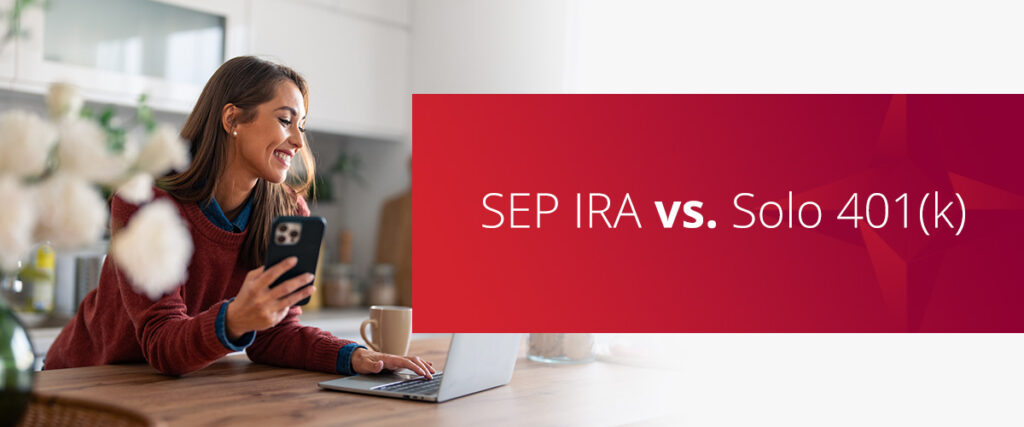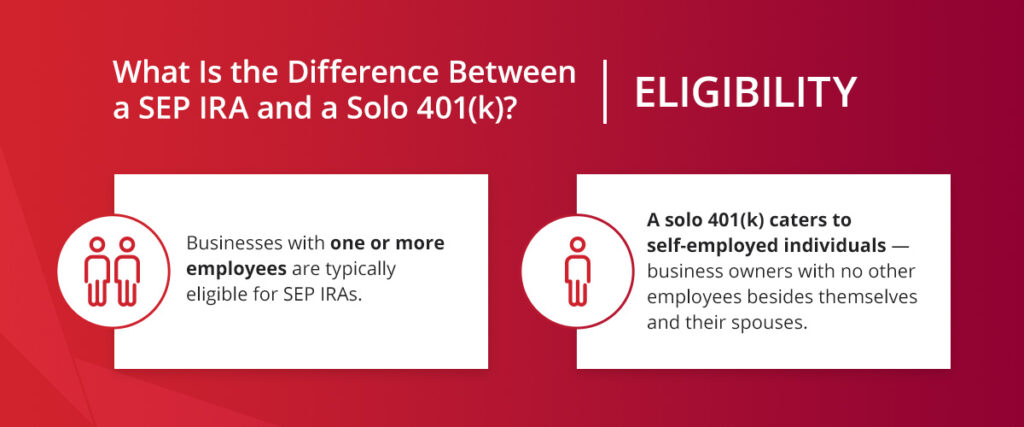
SEP IRAs and solo 401(k)s are both retirement plans for small business owners. However, there are differences in terms of their eligibility requirements, contributions and tax benefits. Before deciding which option is best suited for your business, you’ll want to consider the pros and cons of each. This guide examines the difference between solo 401(k) and SEP IRA plans and discusses the step-by-step process for opening either account.
What Is a SEP IRA?
A Simplified Employee Pension (SEP) IRA is a retirement savings plan created for self-employed and small businesses. The employer makes contributions for themselves and eligible employees and enjoys tax benefits similar to personal IRAs. Additionally, there is less administrative overhead than traditional 401(k) programs, which also have their benefits.
Congress created SEP IRAs in 1978 to extend the IRA concept to small businesses. Like traditional IRAs, the contributions are tax-deductible, and SEP IRAs offer tax-deferred growth on your investments. If you make qualified withdrawals in retirement, the IRS will tax your distributions.
While similar to traditional IRAs, some characteristics are unique to SEP IRAs. A classic example is the contribution limits, which are larger than conventional IRA programs.
Besides the tax benefits, SEP IRAs’ administrative and compliance requirements are generally manageable. They have few reporting requirements and are arguably the simplest way for business owners to save for retirement.
What Is a Solo 401(k)?
A solo 401(k), also known as an individual, self-directed or self-employed 401(k), is a 401(k) retirement savings plan that self-employed individuals establish for their own benefit. In other words, it’s a 401(k) plan designed exclusively for sole proprietors with one employee — themselves. However, spouses working at least part-time may also be eligible to contribute. The business owner can make annual contributions in the capacities of an employee and employer.
Depending on the income, solo 401(k) plans can offer bigger tax deductions and greater annual contribution limits than SEP IRAs. You can fund it on a pre-tax basis, where the investment grows tax-free, and you pay taxes on withdrawals. Alternatively, you can make post-tax Roth contributions, allowing you to withdraw funds tax-free.
The administrative and compliance requirements are also manageable. However, you must file a Form 5500 once you make $250,000 and beyond.
What Is the Difference Between a SEP IRA and a Solo 401(k)?
SEP IRAs and solo 401(k)s are both retirement plans, but there are apparent distinctions. Here are some examples:
1. Eligibility

Businesses with one or more employees are typically eligible for SEP IRAs, including self-employed individuals, sole proprietors, S corporations, C corporations and limited liability partnerships (LLPs). Conversely, a solo 401(k) caters to self-employed individuals — business owners with no other employees besides themselves and their spouses.
Although SEP IRAs are generally more inclusive than solo 401(k)s, there are still eligibility criteria for employees who want to participate. A qualified SEP IRA employee is someone who:
- Is 21 years old or older.
- Has worked with the employer at least three years in the last five years.
- Has received compensation of at least $750 from the employer in 2023 and 2024 and $650 in 2021 and 2022.
2. Contributions
Only employers can make contributions to a SEP IRA account. Employees are generally exempted from making their own elective contributions. Even if the contributor is a self-employed individual, they can only contribute in their capacity as an employer or business owner. With a solo 401(k), self-employed individuals can contribute as employers and employees.
A SEP IRA offers higher contribution limits than other IRA plans. Annual contributions cannot exceed the lesser of 25% of compensation or $69,000 for 2024, an increase from the 2023 limit of $66,000.
The maximum contribution allowed under a solo 401(k) is larger because employees can also contribute. The combined total of employer and employee contributions for solo 401(k) plans was $66,000 for 2023 and $69,000 for 2024 for those under 50. The maximum employee deferral in 2023 was $22,500 and $23,000 for 2024. Contributors aged 50 and older can make additional catch-up contributions of $7,500 for 2023 and 2024.
3. Tax Benefits
Both SEP IRAs and solo 401(k)s have tax benefits, although they operate differently. A solo 401(k) can be funded with pre- or post-tax funds. Pre-tax contributions are tax-deductible, and you pay taxes when you withdraw funds. Post-tax or Roth contributions are not tax-deductible, but growth and withdrawals are tax-free.
The Roth component is non-existent for SEP IRA — they only allow traditional pre-tax contributions.
Considerations for SEP IRAs
A SEP IRA is more inclusive than a solo 401(k) retirement plan. Employers fund these accounts and must contribute the same percentage for all eligible employees. There is no requirement to contribute each year. You can reduce or suspend SEP IRA contributions without penalty if your business struggles financially. However, catch-up contributions for individuals aged 50 and above are non-existent in SEP IRA contributions.
Considerations for Solo 401(k)s
A solo 401(k) is ideal for self-employed individuals, including those whose spouses work as employees. It offers higher contribution limits than a SEP IRA retirement plan since you can contribute as an employer and employee. Unlike a SEP IRA, a solo 401(k) also has pre-tax and post-tax contribution options. Finally, a solo 401(k) is exempt from unrelated debt-financed income (UDFI), providing an added tax advantage over an IRA to purchase real estate.
How to Open a SEP IRA
Here is the step-by-step guide for opening a SEP IRA account:
- Contact a trusted custodian such as Accuplan Benefits Services to open a SEP IRA account.
- Execute a written agreement to provide benefits to all eligible employees. The IRA has a model SEP plan document called Form 5305-SEP.
- Provide employees with the relevant information about the agreement.
- Create an IRA account for each employee.
How to Open a Solo 401(k)
Here is the step-by-step guide for opening a solo 401(k) account:
- Contact Accuplan Benefits Services to open a solo 401(k) account.
- Complete an application form and provide basic information, including your employer identification number (EIN).
- Fund the account by making contributions.
- Choose your preferred investments.
Which Should You Choose: Individual 401(k) or SEP IRA?
A SEP IRA might be best suited if you have employees and prefer high contribution limits and tax-deductible contributions. However, if you have no employees and want even higher contribution limits with flexibility in pre- and post-tax contributions, a solo 401(k) could be ideal. Consider your income, business nature, eligibility and contribution goals before deciding.
Create Self-Employed 401(k) or SEP IRA Accounts With Accuplan

Accuplan Benefits Services has served small and large businesses since 2007. We have a team of professionals with invaluable industry experience ready to support you. Whether you want to open a SEP IRA or a solo 401(k) account, we can provide the platform to establish and manage your investments. Do you want to learn more about our offerings? Contact us now!
Our information shouldn’t be relied upon for investment advice but simply for information and educational purposes only. It is not intended to provide, nor should it be relied upon for accounting, legal, tax or investment advice.